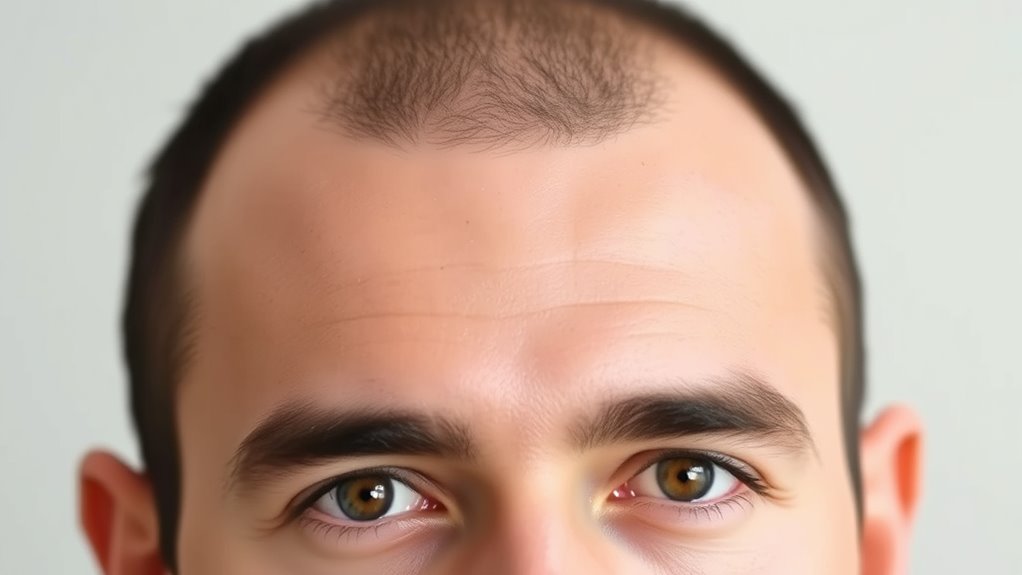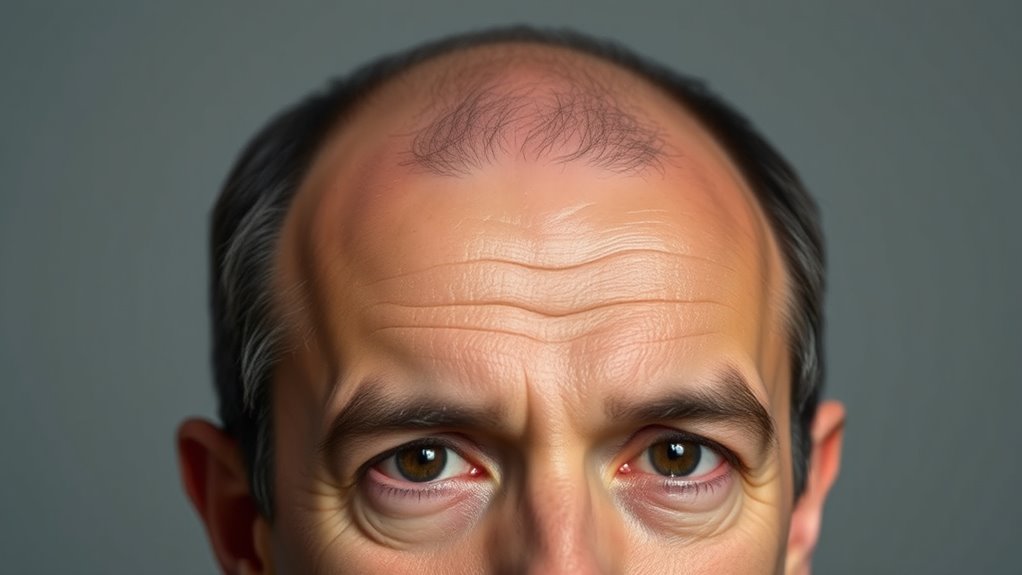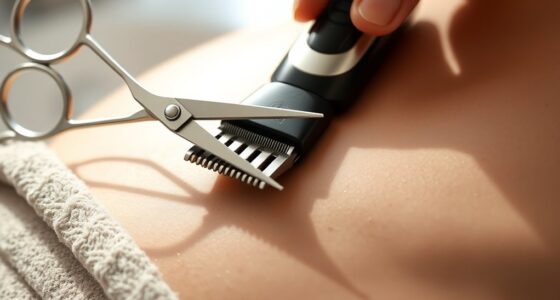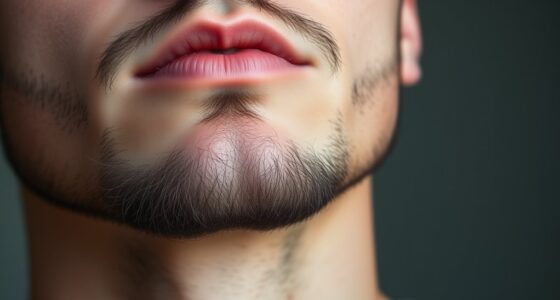To manage a receding hairline, adopt a gentle, sulfate-free shampoo routine and use conditioners or scalp treatments to strengthen your hair. Style strategically by choosing options that add volume or flatter your current hairline, like textured layers or shorter cuts. Protect your hair from environmental damage and avoid tight hairstyles that cause stress. Maintaining a balanced diet and reducing stress also supports hair health. Keep exploring for more tips to boost your confidence and improve your appearance.
Key Takeaways
- Use gentle, sulfate-free shampoos and scalp treatments to strengthen hair and promote scalp health.
- Opt for hairstyles that add volume or create the illusion of fullness, like textured layers or side parts.
- Protect hair from environmental damage and avoid tight hairstyles that stress hair follicles.
- Maintain a balanced diet rich in vitamins and minerals to support hair growth and overall hair health.
- Regularly trim hair, manage stress, and consider professional advice or treatments for persistent receding.

Dealing with a receding hairline can be challenging, but taking proactive steps can help you manage it effectively. The key is to establish a consistent hair care routine that supports scalp health and minimizes further hair loss. Use gentle, sulfate-free shampoos to cleanse your scalp without stripping away natural oils. Incorporate conditioners or scalp treatments designed to strengthen hair follicles and promote a healthy environment for growth. Regularly massaging your scalp can boost blood circulation, which supplies essential nutrients to your hair roots, potentially slowing down the receding process. Avoid harsh chemicals or excessive heat styling, as these can weaken hair strands and contribute to further thinning.
When it comes to hairstyle tips, choosing styles that flatter your current hairline can make a significant difference. Opt for hairstyles that add volume or create the illusion of fullness, such as textured layers, comb-overs, or side parts. These can divert attention from the receding areas and give your hair a thicker appearance. If you prefer shorter cuts, consider a buzz cut or a closely cropped style—these often make thinning less noticeable and are easier to maintain. Be cautious with styles that pull tightly on your hair, like slicked-back looks or tight ponytails, as they can put stress on fragile hair follicles and accelerate recession.
In addition to hairstyle choices, pay attention to your overall hair care routines. Regularly trimming your hair can prevent split ends and keep your hair looking healthier. Using volumizing products, like mousses or powders, can help lift thinning areas and improve the overall look of your hair. Don’t forget to protect your hair from environmental damage, such as sun exposure or pollution, which can weaken hair strands over time. Wearing hats or using UV protectant sprays can shield your scalp and hair from harmful rays.
Finally, maintaining a balanced diet rich in vitamins and minerals—especially iron, biotin, zinc, and vitamins A and E—can support hair health from within. Staying hydrated and managing stress through exercise or relaxation techniques also play fundamental roles in hair retention. Additionally, using high-quality projectors with accurate color reproduction can enhance your entertainment experience. Remember, managing a receding hairline isn’t just about hiding the problem but nurturing your scalp and hair with proper routines and style choices. By combining good hair care routines with smart hairstyle tips, you can boost your confidence and keep your hair looking its best for as long as possible.
Frequently Asked Questions
Are There Natural Remedies to Reverse Hair Loss?
Yes, there are natural remedies you can try to reverse hair loss. Incorporate herbal supplements like saw palmetto or biotin to strengthen your hair, and regularly do scalp massages to stimulate blood flow and promote growth. Consistency is key, so make these habits part of your routine. While results vary, these natural approaches can support healthier hair and may help slow down further loss over time.
How Can I Prevent My Receding Hairline From Worsening?
Think of your hairline as a fragile garden that needs care. To prevent it from worsening, you should address factors like genetic predisposition and hormone imbalance early. Maintain a healthy diet, reduce stress, and avoid harsh styling. Use gentle shampoos and consider treatments like minoxidil. Regular scalp massages boost circulation, helping to strengthen roots. Stay proactive, and you’ll give your hair the best chance to stay resilient against the tide.
What Hairstyles Suit a Receding Hairline?
You should opt for haircut styles that add volume and minimize the appearance of recession, like textured layers or a crew cut. Avoid styles that part your hair directly on the receding area, as they highlight thinning. Use hair accessories like hats or headbands strategically to cover or divert attention. These choices help create a balanced look, giving you confidence while managing your receding hairline effectively.
Are Hair Transplants Permanent Solutions?
Yes, a hair transplant can be a permanent solution, but it depends on various factors. The procedure involves moving hair follicles from one area to another, and these transplanted hairs usually grow naturally for a lifetime. However, considering permanence, you should keep in mind that the health of your remaining hair and scalp conditions can influence results. Consulting with a specialist helps ensure realistic expectations about the longevity of your hair transplant.
Do Certain Foods Promote Hair Growth?
Certain foods can promote hair growth by providing essential nutrients. You should include foods rich in hair-boosting nutrients like biotin, zinc, and iron, which help prevent nutritional deficiencies that cause hair thinning. Eating a balanced diet with eggs, nuts, leafy greens, and lean meats supports healthy hair. By ensuring you get enough of these nutrients, you can help strengthen your hair and potentially encourage growth over time.
Conclusion
Taking charge of your receding hairline might feel overwhelming, but remember, you have options—from styling tricks to medical treatments. Consistency and confidence go hand in hand, and embracing your look can boost your self-esteem. So, why not see the possibilities instead of focusing on what’s lost? With the right approach, you can own your style and face each day with confidence. After all, isn’t feeling good about yourself the ultimate goal?









